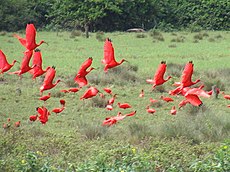Threskiornithidae
| Threskiornithidae | ||
|---|---|---|
 | ||
| Taxonomía | ||
| Reino: | Animalia | |
| Filo: | Chordata | |
| Clase: | Aves | |
| Orden: | Pelecaniformes | |
| Familia: |
Threskiornithidae Richmond, 1917 | |
| Subfamilias | ||
Los tresquiornítidos (Threskiornithidae) son una familia de aves del orden Pelecaniformes[1][2] (antes incluida en el orden Ciconiiformes y se conocían como Plataleidae).[3] Incluye 32 especies[1] de grandes aves terrestres, con dos subfamilias, los ibis y las espátulas.[2]
Características
[editar]Los miembros de esta familia tienen cráneo desmognato, con 16-20 vértebras cervicales y pies anisodáctilos. Tienen las alas largas y anchas con 11 plumas primarias y aproximadamente 20 secundarias. Son buenos voladores, a pesar de su tamaño y peso. El cuerpo es alargado, el cuello más aún, y las patas bastante largas. El pico es largo y, salvo en las espátulas, curvo.
Historia natural
[editar]Su distribución geográfica es prácticamente mundial, encontrándose cerca de cualquier laguna de agua dulce o salobre léntica o lótica. También se encuentran ibis en áreas más secas. Todas las especies son de animales diurnos; se alimentan de una gama amplia de invertebrados y de vertebrados pequeños: los ibis sondean en la tierra o en el barro, las espátulas sobrevolando aguas poco profundas. Por la noche, duermen en árboles cerca del agua. Son gregarios: se alimentan, duermen y vuelan juntos, a menudo en formación.
Anidan en colonias, a menudo en grupos pequeños o individualmente como los pico cuchara, casi siempre en árboles que cuelgan sobre el agua, pero a veces en islas o en islas pequeñas en los pantanos.
Generalmente, las hembras construyen una estructura grande de cañas y ramitas traídas por el macho. Ambos sexos incuban, y después de salidas las crías del cascarón las alimentan por regurgitación. Dos o tres semanas después de salir del cascarón, la cría ya no necesita ser empollada continuamente y puede dejar el nido, pasando a formar parte de la bandada, cerca de los padres para ser alimentado.
Especies
[editar]Subfamilia Threskiornithinae (ibis)
- Género Eudocimus
- Eudocimus albus - Ibis blanco americano
- Eudocimus ruber - Ibis escarlata
- Género Plegadis
- Plegadis falcinellus - Morito común
- Plegadis chihi - Morito cariblanco
- Plegadis ridgwayi - Morito de la Puna
- Género Lophotibis
- Lophotibis cristata - Ibis crestado de Madagascar
- Género Cercibis
- Cercibis oxycerca - Ibis rabudo
- Género Mesembrinibis
- Mesembrinibis cayennensis - Ibis verde
- Género Phimosus
- Phimosus infuscatus - Ibis afeitado
- Género Theristicus
- Theristicus branickii - Bandurria andina
- Theristicus caerulescens - Bandurria mora
- Theristicus caudatus - Bandurria común
- Theristicus melanopis - Bandurria de collar
- Género Threskiornis
- Threskiornis aethiopicus - Ibis sagrado
- Threskiornis bernieri - Ibis sagrado de Madagascar
- Threskiornis melanocephalus
- Threskiornis moluccus
- Threskiornis solitarius † (Extinto)
- Threskiornis spinicollis
- Género Pseudibis
- Género Geronticus
- Género Nipponia
- Género Bostrychia
- Bostrychia bocagei - Ibis de Santo Tomé
- Bostrychia olivacea - Ibis oliváceo
- Bostrychia rara - Ibis manchado
- Bostrychia hagedash - Ibis Hadada
- Bostrychia carunculata - Ibis carunculado
Subfamilia Plateinae (espátulas)
- Género Platalea
- Platalea alba - Espátula africana
- Platalea leucorodia
- Platalea regia
- Platalea minor
- Platalea flavipes
- Platalea ajaja
Referencias
[editar]- ↑ a b Clements, J. F., T. S. Schulenberg, M. J. Iliff, B.L. Sullivan, and C. L. Wood. 2010. The Clements checklist of birds of the world: Version 6.5. Cornell University Press. Downloadable from Cornell Lab of Ornithology
- ↑ a b Peterson, A. P. 2010. Birds of the World -- current valid scientific avian names. Consultado en enero de 2011.
- ↑ BirdLife International 2008. Threskiornis aethiopicus. In: IUCN 2009. IUCN Red List of Threatened Species. Version 2009.1
Enlaces externos
[editar] Wikimedia Commons alberga una galería multimedia sobre Threskiornithidae.
Wikimedia Commons alberga una galería multimedia sobre Threskiornithidae.
Text is available under the CC BY-SA 4.0 license; additional terms may apply.
Images, videos and audio are available under their respective licenses.
